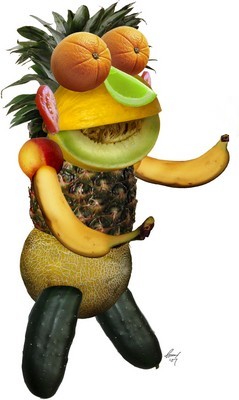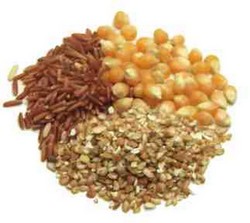

 The traditional four food groups are largely a product of economic lobbying on the part of the food industry, and have little to do with a healthy, natural diet. For example, the calcium requirement of 800 mg. per day was set by lobbying efforts of the dairy industry. Using the theory of nutrition based on the four food groups, we need four cups of milk per day (or its equivalent in cheese, ice cream or other dairy foods). There are 800 mg. of calcium in a quart (4 cups) of cows milk, so theoretically you need four cups of milk or its equivalent to get your 800 mg. of calcium.
The traditional four food groups are largely a product of economic lobbying on the part of the food industry, and have little to do with a healthy, natural diet. For example, the calcium requirement of 800 mg. per day was set by lobbying efforts of the dairy industry. Using the theory of nutrition based on the four food groups, we need four cups of milk per day (or its equivalent in cheese, ice cream or other dairy foods). There are 800 mg. of calcium in a quart (4 cups) of cows milk, so theoretically you need four cups of milk or its equivalent to get your 800 mg. of calcium.
 Furthermore, almost all foods contain some calcium. Cows get their calcium from eating grass! Ever thought about that? When I visited mainland China some years ago, I learned that the Chinese don't use dairy products of any kind. They drink no milk and eat no cheese or yogurt. That means over one billion people (about one-third of the world's population) doesn't consume one of the four essential food groups in human nutrition.�So, how do they survive? They must be riddled with tooth decay, poor bone development, arthritis and osteoporosis, right? Wrong!
Furthermore, almost all foods contain some calcium. Cows get their calcium from eating grass! Ever thought about that? When I visited mainland China some years ago, I learned that the Chinese don't use dairy products of any kind. They drink no milk and eat no cheese or yogurt. That means over one billion people (about one-third of the world's population) doesn't consume one of the four essential food groups in human nutrition.�So, how do they survive? They must be riddled with tooth decay, poor bone development, arthritis and osteoporosis, right? Wrong!
Notes from Four Winds Nutrition.
Environmental toxins could be causing early puberty in girls, according to a study published by the University of Ottawa. In the study, animals exposed to environmental estrogen reached puberty faster than animals not exposed. The study also looked at phytoestrogens, such as those found in plants, and estrogen released into the environment through plastics and other products, and found that children exposed to high levels of environmental estrogenic contaminants may experience early puberty. Scientists are currently studying the link between hormones in meat and dairy and early rates of menarche in young girls, according to researchers at Oasis Advanced Wellness.
Fruits & Vegetables
Botanically speaking, a fruit is the part of the plant which grows out of the flower and bears the seed for the plant. It is part of the plants reproductive function. Fruits, by far, are the easiest of all foods for man to digest, and the food which provides the quickest and cleanest burning fuel.�They are also the foods which we would most naturally be drawn to if we were foraging in the wilds. Hence, fresh raw fruits should have a high priority in our diets. This botanical definition of fruits, however, includes many plants which we think of as vegetables, such as cucumbers, squashes, tomatoes and even green beans. This is because all these foods grow out of the flower and bear the seeds of the plant. Hence, they fit under the classification of herbs bearing seed.�
What is a Vegetable?
Technically-speaking, a vegetable is the vegetative part of the plant, that is, a root, leaf or stem. These plant parts have also been referred to traditionally as herbs. The word herb and the word vegetable are nearly synonymous in their traditional usage. When we eat a vegetable (or an herb), we are eating the plant itself. When we eat a plant's fruit, we are eating that which it has produced as part of its reproductive function. A plant's fruits are unnecessary for its own survival, while its leaves, stems, and roots are very necessary to its survival.
This contrast can also be seen in two other passages found in scripture.�In his vision of a future day, Ezekiel saw the Tree of Life: ...and the fruit thereof shall be for meat (food), and the leaf thereof for medicine.� (Ezekial 47:12). Here we see the difference between the fruit and the leaf (herb or vegetable) illustrated. John saw the same tree and said that ...the leaves of the tree were for the healing of the nations.� (Revelation 22:2).
 Fruitarianism
Fruitarianism
Following these lines of logic, many people have become fruitarians.�That is, they have eaten nothing but raw fruits. These people report that after their bodies have had a chance to clean themselves out� through a series of healing crises� (runny noses, diarrhea, etc.) they have incredible energy, stamina and endurance. One of the foremost promoters of fruitarianism was Arnold Ehret. Ehret overcame his incurable� disease through fasting and eating raw fruits. He lived on nothing but raw fruit for several years, performing great feats of strength and endurance. He raced a trained bicyclist hundreds of miles and won. However, he, like many fruitarians, eventually returned to eating vegetables as well.
One of the foremost promoters of fruitarianism today is T.C. Fry. A couple of T.C. Fry's students, the Diamonds, wrote a best-selling book, Fit for Life, which provides an excellent introduction to these concepts. I believe the concepts taught by T.C. Fry, Ehret, the Diamonds, and others are essentially sound. However, there are three problems I have with their teachings.
First of all, I have observed that fruitarians (and many people who eat nothing but raw foods) are extremely negative and critical in their attitudes.�For example, read some of T.C. Fry's publications. I expected them to list and expound on the positive benefits of eating such a diet. Instead, they are filled with dire warnings about not eating this and not eating that because it's all poisonous, harmful, etc. It almost seems paranoid. Since eating is a very social thing, perhaps eating a diet which is extremely incompatible with western culture can cause people to feel isolated and defensive about their life-style.
Secondly, many people who try to eat nothing but raw fruits and vegetables become very sickly, weak, feeble, cold, pale and wrinkled.�When these people question these results, they are told,� just stick with it, eventually you'll get better.� Unfortunately, that doesn't always happen.�Also, Dr. Rudolph Ballentine, in his book, Diet and Nutrition, notes that Arnold Ehret became a bit of a fruitcake� when he was living on fruit. He walked all over Europe and never stayed in one place for more than a couple of days. He was constantly thinking and could not sit still. Hence, there may be something to saying that a person is a little bit fruity�.�As a sidelight, one of the most interesting books I've read on food is Energetics of Food by Steve Gagne. This book makes a convincing case that different types of food do contribute to different types of temperaments or personalities in man and animals. For instance, people who eat a lot of nuts do become nutty�. They develop temperaments like those of squirrels (which also eat a lot of nuts). They are quick, spry and nervous. The book is fascinating reading and I highly recommend it.
 Grain
Grain
There is one other food which we need to consider: grain (a very interresting site to visit about grains).
Grain is grass seed. Almost all land mammals eat grass. Those mammals that eat meat, eat grass-eating animals. I believe grains (and other seeds, like nuts and beans) constitute a third category of foods which are natural foods for man.�This passage can be better understood in light of another passage from Genesis: And God said, Let the earth bring forth grass, the herb yielding seed, and the fruit tree yielding fruit after its kind.� In other words, tradition has it that there are three basic orders of plants: grass, herbs and trees. I believe these three orders of food represent the three basic types of plant food which man requires: fruits (especially of the trees), vegetables (herbs) and grains (grass-seed).
Of course, that doesn't mean we need to eat our grain in the form of bread.�There are other ways of preparing it for consumption. One of the best ways is to sprout it. In fact, sprouted grain bread (or Essene bread) is very sweet, cake-like and delicious.
The recipe comes from a little book entitled the Essene Gospel of Peace, which purports to be the teachings of Jesus to a group of Essenes on health. He tells them to eat all their food raw and in the season in which it grows. He also instructs them to soak their grains until they sprout, then grind them up and bake them in the hot sun. The book is fascinating reading, even if you don't believe in its authenticity.�
Ann Wigmore brought us further insight into the use of grains with her research into the value of wheatgrass. So grain may also be consumed in its grass form. Barley grass and wheat grass appear to be the most nutritious varieties for man.
Balance
The fact that I have stressed plant foods so highly does not mean that I feel there is no place for animal foods in the diet. We do not live in a garden of Eden paradise and everyone's metabolism is not the same. Some people seem to thrive on a vegetarian diet, some seem to need to eat a little meat and/or dairy products. I met a lady once who felt that all of our health problems came from eating protein. She told me that we didn't need any protein in our diets. When I told her that all foods contain some protein, including fruits and vegetables, she said the proteins must be there as an impurity because of improper cultivation. People get some strange ideas sometimes.
I have been given to understand that Bernard Jensen gave up being a complete vegetarian after he traveled around the world and learned that the healthiest and longest-lived of the world's peoples ate some meat. Weston Price, a dentist who traveled the world studying the diets of various peoples, also found that healthy and long-lived people had some animal protein in their diet. So, I don't eat a great deal of animal protein, but I do eat a little.
So What is a Natural Diet?
 It's about time we got back to our original question. What is the food that is natural for man? If we were put into a zoo, what scientific� diet would we be put on? Well, it certainly wouldn't be a diet of soda pop, hot dogs, hamburgers, french fries, pizza, popcorn, milk shakes and ice cream like the zoo refreshment stands were offering. I think we can safely assume that it would not include white flour, white rice, refined sugar, processed oils and fats or artificial food colorings and flavorings.
It's about time we got back to our original question. What is the food that is natural for man? If we were put into a zoo, what scientific� diet would we be put on? Well, it certainly wouldn't be a diet of soda pop, hot dogs, hamburgers, french fries, pizza, popcorn, milk shakes and ice cream like the zoo refreshment stands were offering. I think we can safely assume that it would not include white flour, white rice, refined sugar, processed oils and fats or artificial food colorings and flavorings.
Most likely it would focus on fresh, tree-ripened fruits, various vegetables and herbs and perhaps whole grains. Most likely it would be a diet of raw foods or at least a large percentage of raw foods. Oh, it might include a little meat, dairy or eggs occasionally, but these foods would not be the central focus of the diet. So, that's what I like to eat. I've gradually been moving away from cooked foods and I've been eating a larger and larger percentage of raw foods, because I think that has to be more natural. (After all, what animal on the face of the earth builds fires and cooks their food?). However, I've learned by past experience not to force changes too quickly. Its easiest to change your diet gradually.
The Scientific Method
Frankly, the most scientific� method I can think of for eating, is to learn to listen to your own body and what it is telling you. Eliminate the obvious junk from your diet and then acquaint your body with a wide variety of fresh fruits, vegetables and seeds. Your body will begin to tell you what it needs if you pay close attention to its reactions to various foods. In fact, one of the most sensible books I've read in recent years promoting raw foods was called Instinctive Nutrition. This book tells of research in France, where sick people have been presented with a wide variety of raw foods. They smell and taste these foods and eat only those foods which smell and taste the best to them. They include raw meat in the foods they offer. They have had tremendous success in helping people get well.�
References
1 World Keys to Health and Long Life, Bernard Jensen
2 The One-Straw Revolution Masanobu Fukuoka. pp.102
3 Improving your Diet with Herbs. Edward Milo Millet. Provo, UT: The
Institute of Creative and Natural Studies, 1976., pp. 3-4.
This information is for educational purposes only. Consult with a qualified health practictioner for all serious or persistant illness.
Copyright � 1999 by Robinson & Horne, L.C., P.O. Box 1028, Roosevelt, UT 84066. This material may be duplicated for educational purposes only (not for resale) provided it is not altered in any way.
Distributed by: Four Winds Nutrition (webnat.com)
|